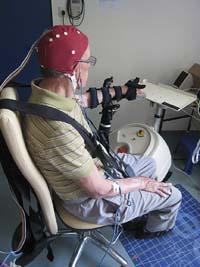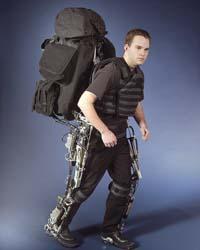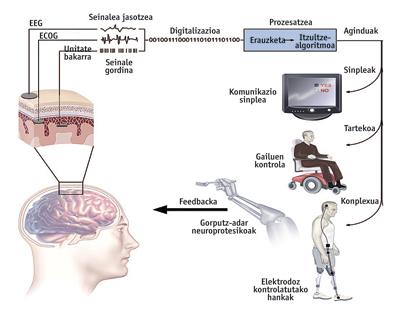Translators of the brain
The brain-computer interfaces are called BCI, Brain Computer Interfaces. They are translators of thought: they read and interpret the intentions of the brain and then convert them into actions. For example, they write what is thought of on a screen or move a robot or a paralyzed tip.
In fact, several teams are investigating this latest application to use it in neuromotor rehabilitation. This is because when a cerebral infarction occurs a series of symptoms occur depending on the affected area. Many have motor problems like hemiplegics. In some cases the movement begins in the brain, but does not reach the muscles because there is a cut.
The researchers have proposed that, due to the plasticity of the brain, a gap can be formed, exciting the elements that intervene in this process through BCI systems. That is, they believe that, by applying adequate stimuli, healthy neurons can do the function of those affected and, therefore, recover the capacity of movement of the patients.
For this purpose they work, among others, at the University Tübingen in Germany, under the direction of Dr. Niels Birbaumer. This group was the first to test this type of systems with patients and is the group in which the donostiarra Ander Ramos is now investigating.
Ramos is a biomedical engineer of the Fatronik Foundation and is doing his doctorate at the prestigious University of Tübing. Ramos acknowledged that "many groups are investigating with people, but ours has been the first to investigate with patients with cerebral infarction."

Tests with patients
Ramos has 1,200 patients in this situation. "Unfortunately, they are getting more and more. This is due to factors such as aging or unhealthy habits of life, but we are increasingly younger (about 30-40 years), many affected by design drugs. We analyze the data of all, such as when they have suffered an accident, why, what consequences they have, etc. And we select the suitable ones for research".
The group of participants must be homogeneous and meet a number of requirements. "For example, they cannot suffer damage to cognition because they must receive training." They perform a double training, train two hours a day with the BCI to adjust the system and improve efficiency, an hour of routine physiotherapy but focused on research.
Collect, filter and interpret
One of the most important phases is the collection of brain signals, which are performed by electroencephalography. For this purpose, there are standardized, non-invasive or invasive methods. In non-invasive, the sensors that receive the signals are placed on the outside of the head, usually a gel is applied to the skin of the head that facilitates the transmission of the signal and the patient does not support more. In invasive methods the sensors are placed inside.

These sensors are much stronger for the patient than non-invasive ones, but the signal received is "cleaner and precise," according to Ramos. When the electrodes are placed outside "the noise always enters, it is easy to move the patient a little, touch the wires or lift the eyebrows and these signals can cover what we want to detect". On the contrary, if the sensor is placed inside or above the brain, "the signal/noise ratio is higher".
Therefore, it is more difficult to filter than to receive the signal, that is, "remove the noise" and interpret it. "It must be taken into account that the brain is always in progress and that the patient who participates in the research, on the one hand, is doing what we promise and, on the other, looks at a screen and tries to understand it..."
In addition, the signals vary from person to person and from the same person according to the moment, "for example, if you have taken a lot of coffee, have eaten a little earlier or have had a bad night, the signal changes." All this hinders the interpretation of the signal.
With the aim of generating neuroplasticity
In addition to electroencephalography for the detection of brain signals, the researchers of the Ramos group use electromyography. Through it the bioelectric activity of the muscles is obtained. Its objective is rehabilitation, that is, to treat the patient to recover their capacity of movement.
The goal is to "provoke neuroplasticity," according to Ramos. Their hypothesis is that they can complement with the BCI the interruption that has occurred in the visual motor tasks. That is why they choose harmless patients in the cortex, where the movement begins.

"The task is a visual engine, for example, to catch a glass," explains Ramos--. First you see the glass and the brain receives this information. Once processed, start the movement, want to take the glass and send to the arm and hand the necessary signals to catch the glass. Finally, take the glass. As we stimulate these elements through the BCI for a month. And what we are looking for is that after that time the patient is able to move the muscle on his own."
Ramos accepts that they have already achieved it with some patients, but with others not. There are many factors that influence the results to be very varied: motivation, whether they have depression or not, which areas have been affected by infarction, etc. For researchers it is essential to know why they have recovered. With this, the aim is to fine-tune the methodology to design a finally marketable product.
However, Ramos spoke prudently about this option: "Five years ago, when I started on this topic, it seemed to me that in ten years there was something commercial, but now I'm not so optimistic." However, in his opinion, the key is not that the system works, but that the product must be very solid and stable and have a reasonable price. "In addition, the authorization processes of the European Union or the United States are very long." That is why he prefers not to give date.
Prisoner in the body
Meanwhile, the University of Tübingen team continues to investigate in BCI technology and has other projects such as amyotrophic lateral sclerosis.

According to Ramos, this is a "terrible" disease: "Patients lose the ability to move slowly and end up in locked, imprisoned in their body. They are conscious, but cannot be moved and cannot be communicated with the outside. We believe that neuroprostheses are the only solution these patients have to communicate with the outside".
In these cases they use BCI, not to excite the elements involved in motor visual tasks, but to stimulate the brain. The researchers believe that in these patients, thinking is going off due to lack of communication and encouragement. Through the BCI they would avoid this.
For the time being, tests have been conducted with a single patient and although the patient responded correctly, they did not achieve continuous communication. However, this has not discouraged them, because they consider that BCI technology can be of great help for this type of patient.
Other applications and ethics
Ramos has expressed his intention to continue working in sanitary applications. According to some researchers, BCI technology can have a rapid development thanks to the investment of video games and leisure companies. Thus, there are already dry electrodes, that is, they do not need room, intended for this type of applications, as the one marketed a couple of years ago by the company Emotiv System under the name of Epoc. However, Ramos doubts whether the helmet really gathers and interprets the signals of the brain. In his opinion, he receives the movements of the muscles of the face and forehead.

Other applications generate ethical doubts. Before traveling to Tübing University, Johns Hopkins studied at the prestigious American university. Despite being one of the most advanced in biomedical research worldwide, Ramos did not like the US Army to be the main investor in BCI technology.
According to Ramos, "as with any technology, the key is in use, you can use a mobile phone to make a bomb explode. The same applies to exoskeletons, for example. We have projects to help the disabled move their limbs through exoskeletons. Well, at Berckeley University a few years ago something like this was developed, and now the U.S. army has something like it to get supersoldiers."
The BCI also interests the army for the knowledge of the images. And it is that the brain finds the image that searches much faster than any computer. When this occurs, a signal is generated in the brain that can be seen through the BCI. This way it can be used to detect and identify enemies. "Military applications can be many," warns Ramos. "But there are much more beneficial applications and I prefer to investigate them."






